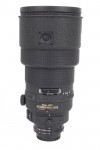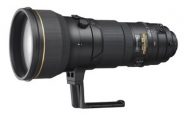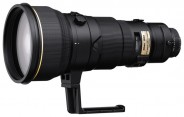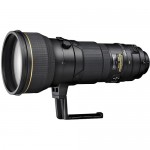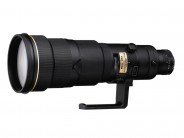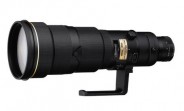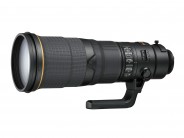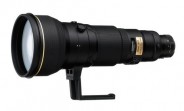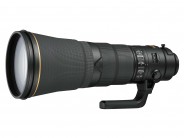Announced
Production status
Original name
System
Pros and cons
- Slow speed
- Internal focusing (IF)
- Short closest focusing distance (1.45m)
- Silent Wave Motor
- Focusing distance range limiter (FULL;3-)
- Manual focus override in autofocus mode
- 9 aperture blades
- No Vibration Reduction (VR)
- Heavy
- Not weather-sealed
- No fluorine coating
- Built-in telescopic lens hood
- Compatible with teleconverters
Genres or subjects of photography
Recommended slowest shutter speed when shooting static subjects handheld
Nikon AF-S Nikkor 300mm F/4D IF-ED
Super telephoto prime lens • Film era
Abbreviations
| AF-S | The lens is equipped with Silent Wave Motor. |
| D | The lens relays subject-to-camera distance information to the camera. |
| IF | Internal focusing. |
| ED | The lens incorporates low dispersion elements. |
Model history
| ■Nikon Nikkor 300mm F/4.5 ED | A | 6 - 4 | 4.00m | ⌀72 | 1977 ● | |
| ■Nikon AI Nikkor 300mm F/4.5 ED | A | 6 - 4 | 4.00m | ⌀72 | 1977 ● | |
| ■Nikon AI Nikkor 300mm F/4.5 IF-ED | A | 7 - 6 | 2.50m | ⌀72 | 1978 ● | |
| ■Nikon AI-S Nikkor 300mm F/4.5 IF-ED | A | 7 - 6 | 2.50m | ⌀72 | 1981 ● | |
| ■Nikon AF Nikkor 300mm F/4 IF-ED | A | 8 - 6 | 2.50m | ⌀82 | 1987 ● | |
| ■Nikon AF-S Nikkor 300mm F/4D IF-ED | A | 10 - 6 | 1.45m | ⌀77 | 2000 ● | |
| ■Nikon AF-S Nikkor 300mm F/4E PF ED VR | A | 16 - 10 | 1.40m | ⌀77 | 2015 ● | |
Specification

| Optical design: | |
| 300mm | |
| F/4 | |
| 35mm full frame | |
| Nikon F [46.5mm] | |
| 8.2° (35mm full frame) | |
| 10 elements in 6 groups | |
| 2 ED | |
| Internal focusing (IF) | |
| On Nikon D APS-C [1.53x] cameras: | |
35mm equivalent focal length: | 459mm (in terms of field of view) |
35mm equivalent speed: | F/6.1 (in terms of depth of field) |
Diagonal angle of view: | 5.4° |
| Diaphragm mechanism: | |
Diaphragm type: | Automatic |
Aperture control: | Aperture ring (Manual settings + Auto Exposure setting) |
| 9 (nine) | |
| Focusing: | |
| 1.45m | |
| 1:3.65 | |
Focusing modes: | Autofocus, manual focus |
Autofocus motor: | Silent Wave Motor |
Manual focus control: | Focusing ring |
Focus mode selector: | M/A - M |
Manual focus override in autofocus mode: | Yes |
Focusing distance range limiter: | FULL;3- |
| Vibration Reduction (VR): | |
| - | |
| Physical characteristics: | |
| 1300g | |
| ⌀90×222.5mm | |
| - | |
| - | |
| Accessories: | |
| Screw-type 77mm | |
| Built-in telescopic round | |
| Nikon AF-I Teleconverter TC-14E → 420mm F/5.6 | |
| Nikon AF-S Teleconverter TC-14E II → 420mm F/5.6 | |
| Nikon Teleconverter TC-14B → 420mm F/5.6 | |
| Nikon AF-S Teleconverter TC-17E II → 510mm F/6.8 | |
| Nikon AF-I Teleconverter TC-20E → 600mm F/8 | |
| Nikon AF-S Teleconverter TC-20E II → 600mm F/8 | |
| Nikon AF-S Teleconverter TC-20E III Aspherical → 600mm F/8 | |
| Nikon Teleconverter TC-300 → 600mm F/8 | |
| Nikon Teleconverter TC-301 → 600mm F/8 |
Source of data
- Manufacturer's technical data.
Manufacturer description #1
MELVILLE, N.Y., Aug. 28 /PRNewswire/ -- Nikon today announced its newest pro quality telephoto lens -- the AF-S Nikkor 300mm f/4D ED-IF. Ideal for a wide range of picture taking, from sports and action, to extraordinary tight-close-up portraits, to general landscape photography, this new compact telephoto lens combines Nikon's superior optical quality with the legendary Nikon Silent Wave Motor for fast, quiet, and accurate autofocus.
Nikon's Silent Wave Motor design provides maximum autofocus performance with speed and accuracy, together with Nikon's extensive high performance family of SLR models: D1 Pro Digital SLR, Pro 35mm F5, F100, N90, advanced N80, Pronea S, Pronea 6i and the newly released compact N65 SLR. Because this new lens features Nikon's legendary F lens mount, with triple claw bayonet, its manual focusing performance is compatible with the full range of Nikon SLR models, including those named above and every other Nikon SLR made since 1959. This interchangeable compatibility is an exclusive Nikon advantage and compliments Nikon's concept of Total Imaging System and System Integrity.
When used with Nikon's compatible Autofocus SLR models, this lens' advanced M/A mode allows instant switching from automatic to manual focusing, even during AF servo operation. This means that if a user needs to take over focusing, for any reason, the compatible Nikon will instantly respond. Also, manual focusing performance does not require battery power ... another Nikon advantage.
AF-S is Nikon's designation that the lens is built with Nikon's exclusive Silent Wave Motor (SWM). The new AF-S Nikkor 300mm f/4D ED-IF enjoys the superb performance of the SWM. Autofocus operation is virtually silent, but more importantly, it is supremely fast and accurate. Subjects will "pop" into focus, almost faster than one can realize it's happening. Some have said, "It happened so fast I could not even realize that it was focusing!"
This new AF-S 300mm f/4D ED-IF Nikkor, and every AF-S Nikkor are a superb choice for indoor and outdoor action photography. Superior Nikkor optical design compliments this lenses smooth mechanical construction. The optical design includes two major features: Extra Low Dispersion Optical Glass and Internal Focusing Optical Design. Extra Low Dispersion optical glass elements virtually eradicate secondary optical chromatic aberrations; such aberrations are typical in ordinary telephoto optics. The result is that in pictures made with this new lens, virtually the entire visual spectrum of color is focused on the same plane -- producing superior color detail and contrast throughout the lens' focusing range and aperture selection.
Optical coatings are a critical component of every lens' design, so Nikon applies its best to this new lens: Nikon Super Integrated Optical coating is applied to enhance the new lens' image quality for crisper color rendition and reduced flare and ghosting.
As conventional telephoto optics are focused, the lens extends and contracts; this changes the lens' size and balance. Internal Focusing design enables the lens to be both auto-focused and manually focused without changing the lens' size with a negligible change in balance. The result is precise handling throughout the focusing range, from infinity to as close as 4.8 feet; and focusing is fast, crisp and accurate. Close focusing to a mere 4.8 feet gives photographers the ability to make dramatic portraits.
Still more performance improvements are provided through the lens' 9-blade aperture. More blades than an ordinary lens, this addition produces a more rounded aperture. The result is more natural looking highlights and crisper details throughout the picture.
Nikon D-type design provides distance information to the camera's computer. This information is used to achieve more precise exposure control, both for flash and for ambient light metering. A detachable tripod mounting collar is provided, as is a built-in lens hood that minimizes stray light. The lens' exterior finish is textured to provide a superior grip. For added versatility, the lens is fully compatible with the Nikon TC-14E Teleconverter, increasing the focal length to 420mm with 35mm SLR cameras. Used with Nikon's Pro Digital D1 SLR, the teleconverter's magnification produces the effective coverage of a 630mm lens.
The new Nikon AF-S Nikkor 300mm f/4D ED-IF will be available beginning in October of 2000.
Manufacturer description #2
Offering an excellent balance between size, speed and image quality, the fast AF-S NIKKOR 300mm f/4D IF-ED produces great sharpness, making it an ideal super-telephoto lens for sports, wildlife or travel applications. If greater reach is needed, it’s fully compatible with all Nikon teleconverters. It even handles close-up shooting suprisingly well.
The AF-S NIKKOR 300mm f/4D IF-ED delivers exceptionally clear images from remarkeable distances. It’s fixed 300mm focal length lets you get closer to the excitement of a sporting event, the natural splendor of wildlife and the breathtaking details of a landscape. And because of its compact size and lightweight construction, it’s perfect for carrying around during a full day of shooting. Combine it with a Nikon teleconverter, and you can achieve up to an astounding 600mm of reach!
The AF-S NIKKOR 300mm f/4D IF-ED delivers the exceptional image quality and performance that has made NIKKOR lenses famous. Nikon’s Silent Wave Motor (SWM) enables ultra-fast, ultra-quiet autofocusing with seamless manual override. Extra-low Dispersion (ED) glass produces superior sharpness, contrast and color, even in challenging lighting situations. And the Internal Focusing (IF) design keeps the lens compact and lightweight.
From the editor
On paper this lens looks impressive as in addition to IF and ED glass the minimum focus distance is reduced to an incredibly short 1.5m, and it has the Silent Wave motor technology to drive the AF from within the lens. Optically it is superb and produces images of the highest quality from corner to corner, and the AF action is fast and positive. Sadly this lens has a major flaw: its tripod collar. Used in the critical range of shutter speeds between 1/30 sec and 1/2 sec, when the effect of camera vibration is most likely to manifest itself, many photographers found the collar and foot to be insufficiently rigid to guarantee sharpness. Although unconfirmed by Nikon it appears the collar underwent a re-design around mid-2001, and this seems to have addressed the issue of rigidity.
Compared to other super telephoto prime lenses in the Nikon F system
- One of the shortest closest focusing distances (1.45m)
- Largest magnification (1:3.65)
- One of the lightest (1300g)
- Accepts front filters, along with 3 other models
Other super telephoto prime lenses in the Nikon F system
Sorted by focal length and speed, in ascending order
Lenses with similar focal length
Sorted by manufacturer name
| ■Nikon F mount (2) | |||||||||
| Sigma 300mm F/4 APO Macro ZEN • ⌀77 | Pro | 1994 ● | Compare | 1 | 3 | ||||
|
|
|||||||||
| Tokina AT-X AF 300mm F/4 • ⌀77 | Pro | 1995 ● | Compare | 0 | 5 | ||||

|
|||||||||
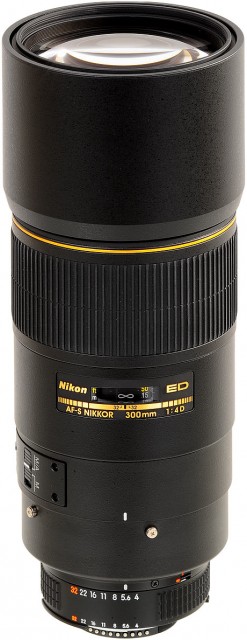

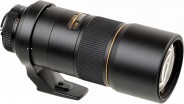

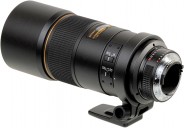


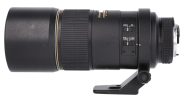

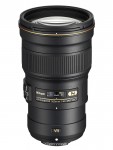
![Nikon AF Nikkor 300mm F/2.8 ED-IF [I]](https://lens-db.com/wp-content/uploads/2012/10/af-300-28-ed-02-101x150.jpg)
![Nikon AF Nikkor 300mm F/2.8 ED-IF [II]](https://lens-db.com/wp-content/uploads/2015/03/nikon-af-300-28-ed-03-126x150.jpg)
